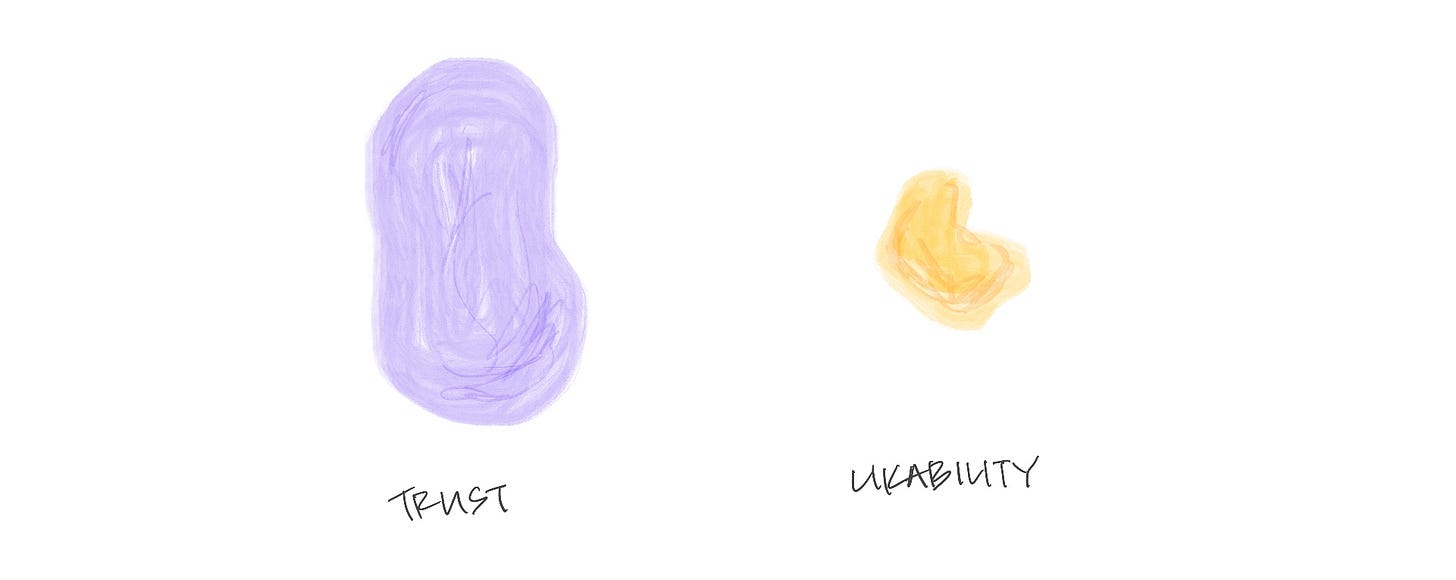Repairing What's Broken
How to mend trust after a RIF, reorganization, strategic change (or really any kind of mistake, flub, or fracture)
👋 Howdy! Claire here, Founder & CEO of Canopy. I've spent the last decade studying 50+ years worth of leadership research and training 30,000+ leaders. Each week, I distill all my learnings in this weekly newsletter.
Do please make sure you’re subscribed so you can receive a fresh piece each week, and consider sharing with a friend or colleague who you think might enjoy as well…
“I'm in repair. I'm not together but I'm getting there.”
I've always loved this lyric from John Mayer. (He admittedly might have quite a bit to apologize for in his personal life!) Yet, the struggle he describes in this song — the pain of broken trust in a relationship — is resonant beyond just his own foibles.
Broken trust is an unwelcome reality that can reverberate in any relationship…including work relationships.
Trust is as fragile in the workplace as it is anywhere else. An announcement of layoffs that blindsides your team. A reorganization that leaves people cautious and questioning their future. A strategic pivot that seems to sideline the company's core values. Even a routine process handled poorly can fracture the foundation of trust you've spent years building as a leader.
When trust breaks, the silence in the room is deafening. Team members who once freely shared ideas now guard their thoughts. The energy that used to fuel a collectively confident “carpe diem!” is now frenetic and anxious. Collaboration gives way to self-preservation.
I've sat with leaders in these moments, watching them grapple with what feels like an impossible task. “How do I rebuild what's broken?” they've asked me.
Here's what I tell them: There is a path forward. After working with thousands of leaders, I've discovered that a window for repair exists — though, the window is often narrow and demands swift, intentional action. The journey to rebuilding trust isn't about quick fixes or surface-level balms. It requires fundamental shifts in both thinking and behavior, as a leader.
If you're ready to dig deep, let's dive in.
1st Key Shift: Trust doesn't equal likability
After a major restructuring, one CEO I worked with immediately arranged an elaborate team retreat with premium perks and ample social activities. She was stunned when this approach made her team even more withdrawn.
Why? Because she was trying to solve a problem about trust with a solution about optimizing for likability. It's the wrong solution for the problem at hand.
When trust fractures, our instinct as leaders is to reach for what we think might curry a sense of likability or good will: Surprise bonuses, team-building retreats, positive compliments. But consider this: You can like someone without trusting them. And the reverse is also true… You can trust someone you don't particularly like.
Trust does not equate to likability. And so these remedies aimed to foster greater likability don't just fail — they often deepen the wound. When employees notice leaders organizing happy hours while avoiding difficult conversations about why trust was broken in the first place, it reads as inauthentic at best and manipulative at worst. The team's frustration grows because these gestures feel disconnected from the real issues at hand.
What you're attempting to repair is what scholars call "affective trust" — the emotional connection and rapport between people. While this is certainly one dimension of trust, when organizational trust breaks, the issue usually runs much deeper than whether people feel a personal connection with you as a leader.
The fundamental misunderstanding here is conflating rapport with reliability. Rebuilding genuine trust requires looking beyond whether your team members feel comfortable around you to whether they believe you'll do what you say you'll do… which brings us to our second key shift.
2nd Key Shift: Trust = Intentions matching actions
When a senior executive announced a new “collaborative decision-making process” but then made three major decisions without any team input the following week, the disconnect was glaring. What disintegrated wasn't personal rapport — it was the alignment between stated intentions and observable actions.
What's truly damaged when trust breaks is what researchers call “cognitive trust”— the fundamental belief that your words and actions align. At its core, your team needs to believe that what you say matches what you do. Trust erodes rapidly when people perceive a gap between these two elements: Intentions and actions.
Let’s take a look at how this has played out in real life…
I worked with an organization whose senior leadership team genuinely intended to help employees feel valued and heard. The company's stated commitment was that leadership would support team members and ensure their voices influenced decisions. However, when they implemented an aggressive performance management system without any context, people interpreted it as a thinly veiled excuse to eliminate staff and undermine even high performers.
This perception — regardless of whether it matched leadership's actual intentions — shattered trust throughout the organization. The critical fracture wasn't about whether people liked their leaders, but that they no longer believed the leaders' actions reflected their stated intentions.
To begin repairing trust, you must ask yourself this essential question: What was your original intention as a leader in the initiative that's causing distrust? And what specific actions might people be interpreting differently, as not matching that intention?
This gap — between how you intended your actions to be perceived and how they're actually being interpreted — is precisely where trust reconstruction begins.
3rd Key Shift: Clarify intention, align actions
Once you've recognized that broken trust stems from misalignment between intentions and actions, the path forward becomes clearer. Rebuilding trust requires deliberate work on both sides of this equation.
The repair process isn't complex in theory, but it demands courage and consistency in practice:
Clarify your intention with transparency
Don't just restate your original intention — acknowledge where things went wrong. For example, "Our intention with the reorganization was to create more growth opportunities for everyone, but we failed to explain how these changes would benefit each of you." This vulnerability signals authenticity and opens the door to real dialogue.
Realign your actions to visibly match your intention.
Words alone won't rebuild trust. Every decision, policy change, and communication must reflect your stated intention. When you say employee well-being matters, ensure your next decisions prioritize it in visible ways.
The key is consistency across every touchpoint. One misaligned action can undo months of trust-building efforts. Think of trust as a bridge you're reconstructing: Each plank must be solid and secured before the next is added.
Remember that timing matters as well. In the wake of broken trust, your team will scrutinize your actions with heightened sensitivity. This vigilance isn't personal — it's a natural protective mechanism. Respond not with defensiveness but with patient, persistent demonstration that your intentions and actions are now in lockstep.
This alignment work isn't a one-time fix but rather a continuous practice that gradually rebuilds the foundation of trust. With each aligned action, you lay another plank to rebuild what's broken.
Applying this to real scenarios
With the gap between intention and action in mind, the process of rebuilding trust requires three steps:
Define your intention with personal honesty: Get clarity within yourself first about what you truly intended.
Identify the gaps: Recognize where actions didn't align with these genuine intentions.
Let actions do the talking: Implement visible changes that demonstrate your intentions, rather than just explaining them.
Of course, doing this in real life is much more nuanced and trickier than what any 3-step framework can capture. As a result, here are some scenarios as examples to help anchor you, as you consider repairing trust in your own team…
A Reorganization: Rebuilding trust after a structural change
Your team was promised clearer paths to growth and better collaboration through reorganization. Yet months later, confusion reigns and skepticism has replaced optimism. People are questioning if this was just change for change's sake.
Step 1: Define your intention honestly, with yourself
Before involving others, ask yourself: "What was our true intention with this reorganization? Was it really about improving work-life for everyone, or primarily about efficiency and cost-cutting?" This honest self-assessment is crucial for authentic next steps.
After grounding yourself in your own personal sense of clarity, you’ll want to also make sure you’re aligned with your leadership team on the genuine purpose of the reorg.
Step 2: Identify the intention-action gaps
Reflect on where the roll-out of the reorg may have contradicted your desired intentions. For instance:
People’s roles remain unclear, despite promises of improved clarity around responsibilities.
Frontline manager have been so frequent, it suggests disorganization, not strategy.
Benefits of the reorganization remain theoretical for most employees — work currently feels harder to get done, not easier.
Step 3: Let actions do the talking
Rather than relying on lengthy explanations about how the reorg is “supposed” to work, implement visible changes that address the intention-action gaps. For example:
Create and distribute clear role documentation that actually solves confusion.
Establish stability in reporting structures with a commitment to consistency, and when another change might be anticipated in the future, and why.
Focus on identifying and fixing specific pain points around workflow and cross-functional collaboration that the reorganization was meant to address.
A Reduction in Force (RIF): Reassuring the remaining team
The difficult decision to reduce headcount has left surviving team members shaken. Backchannel conversations revolve around “who's next” rather than future opportunities. Productivity is suffering as anxiety rises.
Step 1: Define your intention honestly, with yourself
It’s time to ask yourself some difficult questions: “Was this truly unavoidable? Was there anything in our control earlier, as a company, that could have prevented this RIF from happening in the first place? What was my (and our leadership team’s) primary concern — the business, the employees, or both??
As painful as it might be to even consider these questions, they can help you cut through your own fog. The more real you can be with yourself, the more real you can be with your team. Your honest self-assessment will prevent hollow messaging later.
Once you’ve let yourself be real with yourself on the intentions of the RIF, then of course align with your leadership team, with what your learnings from this are, going forward.
Step 2: Identify the intention-action gaps
Then, consider how the intention of the RIF to put the company in a position for long-term success may in fact contradict the actions surrounding the RIF. For example:
Current messaging is forcibly optimistic and not reflective of the somber and hard decision this was.
In hindsight, departures were handled too brusquely, in contrast with state company values.
The workload that remains from departed employees and falls onto the lap of existing employees is in direct conflict with the company’s claims about valuing employees.
Step 3: Let actions do the talking
Demonstrate your true intention and values through concrete actions. For instance:
Adjust communications to acknowledge the difficult moment and give current employees time to process the decision by extending or removing deadlines.
Find ways to immediately reduce workload for teams on the remaining work, or communicate a clear plan for how the remaining work will be tackled.
Make visible changes to company operations to ideally prevent a RIF in the future — or at the very least, changes to how RIF departures are handled in the future.
A Strategic Change: Realigning trust after a pivot
After years of focusing on one direction, your company has announced a significant strategic shift. Long-time employees are struggling to see how their expertise remains relevant, while others wonder if this is just another fleeting idea that leadership is over-excited about.
Step 1: Define your intention honestly, with yourself
Ask yourself: "What is truly driving this change? Is it market conditions, competitive pressures, or something else?" This honesty ensures your subsequent actions come from an authentic place.
After gaining personal clarity, then align with your leadership team.
Step 2: Identify the intention-action gaps
Reflect on potential contradictions of a strategic change that undermine trust. For instance:
The new strategic direction could seem like a departure from the original company values.
Past patterns of strategy shifts further contributes to a sense of inconsistency about the company’s long-term vision.
Statements on the new direction are abstract and don’t give any concrete clarity on roles, projects, prioritization for teams.
Step 3: Let actions do the talking
Show through tangible actions that the new strategic direction underscores your intention. For example:
Give specific examples of projects of how the new strategic direction in fact supports the original company values.
Create visible connections between past projects and new priorities — how what was worked on before and what will be worked on in the future is all building toward the long-term vision.
Provide write-ups and documentation of the exact implication for team around what will now be prioritized, how projects will change, and the impact this has on each person’s role.
Rebuilding a bridge you didn't break
“But what if I didn't cause this?” I hear you. When you’re not the one who precipitated the rupture in trust, you are merely left with the destruction in the aftermath. It’s not your intention and actions you’re dealing with — it’s someone else’s.
Your hands are tied. Whether you're implementing a reduction in force you didn't plan or announcing a reorganization you just learned about, you’re also likely upset about these changes as well.
In these moments, focus on what you can control:
Your authenticity matters. Be honest about what you know and don't know. Your team respects candor more than corporate lines that ring hollow. For example, you can say: “I don’t have the information but will do my best to get it.”
Your sphere of influence is holds weight. While you can't change organizational direction, you control how changes unfold within your team. Create clarity around new expectations and provide psychological safety for honest conversations. For instance, you might say: “In the coming weeks, I’d love to have a 1:1 with each of you so we can discuss what you’re thinking and feeling in light of these changes.”
You're a translator, not just a messenger. You help your team make sense of chaos by connecting larger changes to their daily work — perhaps your most valuable contribution during trust breakdowns. For example, you might say: “As disruptive that this new change is, the work you do day-to-day still matters to our customers in this way…”
Remember, too, that you're also experiencing this breach of trust. Your own relationship with senior leadership may be strained. Acknowledge this reality for yourself rather than suppressing it, and so you don’t put more pressure on yourself that you’re already bearing.
You cannot single-handedly rebuild what's broken at the organizational level. But within your sphere of influence, the alignment between your own intentions and actions can create an island of trust in a sea of uncertainty.
Sometimes, that island is enough to keep your team afloat until larger repairs can be made.
Getting there
“I'm not together, but I'm getting there.”
The lyric continues to resonate: “I’m getting there.”
You are getting there. You are reading this newsletter. You are thinking about ways to strengthen trust in your team and mend what was broken, even if you weren't the person who broke it. And in that effort, in your courage you gather to be honest about your intentions, and in the discipline you muster to align your actions with your intentions, you make more progress toward trust than ever before.
As the cliche goes: It's a journey, not an event. Some days, the trust gap may still feel impossibly wide. Other days, you'll glimpse the emerging structure of what you're rebuilding. Both experiences are part of the process.
The value of repair doesn't come from certainty that you'll fully succeed, but from the conviction that the relationship is worth the effort. Your team doesn't expect perfection — they just need to see that you're genuinely committed to the work of rebuilding.
Your team will be grateful for that commitment.
-Claire
If you found my writing useful this week, feel free to “like” or “share” the post — it helps other folks who might find this piece similarly useful see it for free 🫶
If you’re keen to rebuild trust in your organization, here are ways you can directly work directly with me, Claire, Founder & CEO of Canopy:
🧠 Consider having me advise you and/or your leadership team on navigating trust post-RIF, reorganization, or strategic direction.
📣 Invite me to deliver team keynotes and workshops, remotely or in person on topics that help leaders with rebuilding trust, especially post-reorganization or acquisition or strategic change.
🚂 Partner with me to roll-out a leadership training program for your managers to help with building and restoring greater team trust.
🌿 Use Canopy, our lightweight leadership learning app, in your day-to-day, that include primers and reminders on how to build trust in a team.
I’d be honored to chat and see what might be the best fit for you. Feel free to reach out to me directly here 💚









